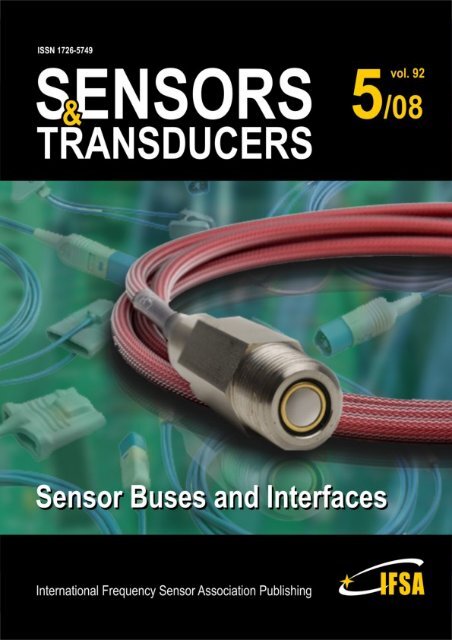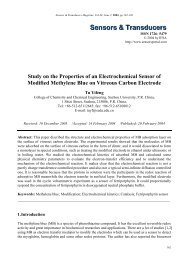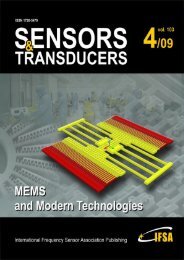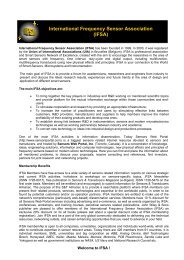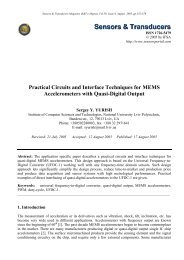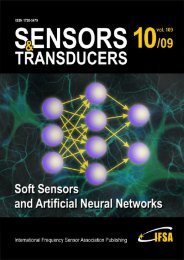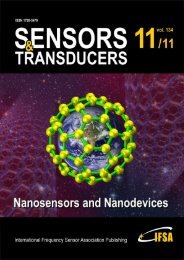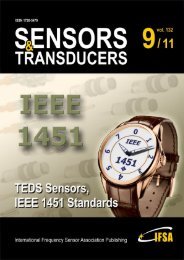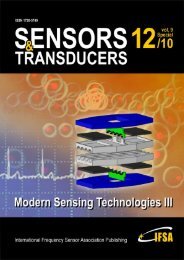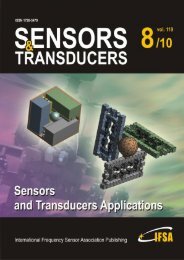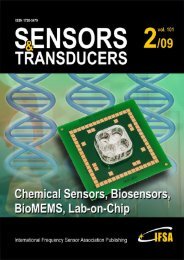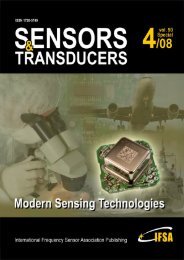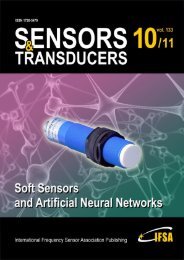Recent Advances in DNA Biosensor - International Frequency ...
Recent Advances in DNA Biosensor - International Frequency ...
Recent Advances in DNA Biosensor - International Frequency ...
Create successful ePaper yourself
Turn your PDF publications into a flip-book with our unique Google optimized e-Paper software.
Sensors & Transducers<br />
Volume 92<br />
Issue 5<br />
May 2008<br />
www.sensorsportal.com ISSN 1726-5479<br />
Editor-<strong>in</strong>-Chief: professor Sergey Y. Yurish, phone: +34 696067716, fax: +34 93 4011989,<br />
e-mail: editor@sensorsportal.com<br />
Editors for Western Europe<br />
Meijer, Gerard C.M., Delft University of Technology, The Netherlands<br />
Ferrari, Vittorio, Universitá di Brescia, Italy<br />
Editors for North America<br />
Datskos, Panos G., Oak Ridge National Laboratory, USA<br />
Fabien, J. Josse, Marquette University, USA<br />
Katz, Evgeny, Clarkson University, USA<br />
Abdul Rahim, Ruzairi, Universiti Teknologi, Malaysia<br />
Ahmad, Mohd Noor, Nothern University of Eng<strong>in</strong>eer<strong>in</strong>g, Malaysia<br />
Annamalai, Karthigeyan, National Institute of Advanced Industrial<br />
Science and Technology, Japan<br />
Arcega, Francisco, University of Zaragoza, Spa<strong>in</strong><br />
Arguel, Philippe, CNRS, France<br />
Ahn, Jae-Pyoung, Korea Institute of Science and Technology, Korea<br />
Arndt, Michael, Robert Bosch GmbH, Germany<br />
Ascoli, Giorgio, George Mason University, USA<br />
Atalay, Selcuk, Inonu University, Turkey<br />
Atghiaee, Ahmad, University of Tehran, Iran<br />
Augutis, Vygantas, Kaunas University of Technology, Lithuania<br />
Avachit, Patil Lalchand, North Maharashtra University, India<br />
Ayesh, Aladd<strong>in</strong>, De Montfort University, UK<br />
Bahreyni, Behraad, University of Manitoba, Canada<br />
Baoxian, Ye, Zhengzhou University, Ch<strong>in</strong>a<br />
Barford, Lee, Agilent Laboratories, USA<br />
Barl<strong>in</strong>gay, Rav<strong>in</strong>dra, RF Arrays Systems, India<br />
Basu, Sukumar, Jadavpur University, India<br />
Beck, Stephen, University of Sheffield, UK<br />
Ben Bouzid, Sihem, Institut National de Recherche Scientifique, Tunisia<br />
B<strong>in</strong>nie, T. David, Napier University, UK<br />
Bischoff, Gerl<strong>in</strong>de, Inst. Analytical Chemistry, Germany<br />
Bodas, Dhananjay, IMTEK, Germany<br />
Borges Carval, Nuno, Universidade de Aveiro, Portugal<br />
Bousbia-Salah, Mounir, University of Annaba, Algeria<br />
Bouvet, Marcel, CNRS – UPMC, France<br />
Brudzewski, Kazimierz, Warsaw University of Technology, Poland<br />
Cai, Chenx<strong>in</strong>, Nanj<strong>in</strong>g Normal University, Ch<strong>in</strong>a<br />
Cai, Q<strong>in</strong>gyun, Hunan University, Ch<strong>in</strong>a<br />
Campanella, Luigi, University La Sapienza, Italy<br />
Carvalho, Vitor, M<strong>in</strong>ho University, Portugal<br />
Cecelja, Franjo, Brunel University, London, UK<br />
Cerda Belmonte, Judith, Imperial College London, UK<br />
Chakrabarty, Chandan Kumar, Universiti Tenaga Nasional, Malaysia<br />
Chakravorty, Dipankar, Association for the Cultivation of Science, India<br />
Changhai, Ru, Harb<strong>in</strong> Eng<strong>in</strong>eer<strong>in</strong>g University, Ch<strong>in</strong>a<br />
Chaudhari, Gajanan, Shri Shivaji Science College, India<br />
Chen, Jim<strong>in</strong>g, Zhejiang University, Ch<strong>in</strong>a<br />
Chen, Rongshun, National Ts<strong>in</strong>g Hua University, Taiwan<br />
Cheng, Kuo-Sheng, National Cheng Kung University, Taiwan<br />
Chiriac, Horia, National Institute of Research and Development, Romania<br />
Chowdhuri, Arijit, University of Delhi, India<br />
Chung, Wen-Yaw, Chung Yuan Christian University, Taiwan<br />
Corres, Jesus, Universidad Publica de Navarra, Spa<strong>in</strong><br />
Cortes, Camilo A., Universidad Nacional de Colombia, Colombia<br />
Courtois, Christian, Universite de Valenciennes, France<br />
Cusano, Andrea, University of Sannio, Italy<br />
D'Amico, Arnaldo, Università di Tor Vergata, Italy<br />
De Stefano, Luca, Institute for Microelectronics and Microsystem, Italy<br />
Deshmukh, Kiran, Shri Shivaji Mahavidyalaya, Barshi, India<br />
Dickert, Franz L., Vienna University, Austria<br />
Dieguez, Angel, University of Barcelona, Spa<strong>in</strong><br />
Dimitropoulos, Panos, University of Thessaly, Greece<br />
D<strong>in</strong>g Jian, N<strong>in</strong>g, Jiangsu University, Ch<strong>in</strong>a<br />
Djordjevich, Alexandar, City University of Hong Kong, Hong Kong<br />
Editorial Advisory Board<br />
Editor South America<br />
Costa-Felix, Rodrigo, Inmetro, Brazil<br />
Editor for Eastern Europe<br />
Sachenko, Anatoly, Ternopil State Economic University, Ukra<strong>in</strong>e<br />
Editor for Asia<br />
Ohyama, Sh<strong>in</strong>ji, Tokyo Institute of Technology, Japan<br />
Donato, Nicola, University of Mess<strong>in</strong>a, Italy<br />
Donato, Patricio, Universidad de Mar del Plata, Argent<strong>in</strong>a<br />
Dong, Feng, Tianj<strong>in</strong> University, Ch<strong>in</strong>a<br />
Drljaca, Predrag, Instersema Sensoric SA, Switzerland<br />
Dubey, Venketesh, Bournemouth University, UK<br />
Enderle, Stefan, University of Ulm and KTB Mechatronics GmbH,<br />
Germany<br />
Erdem, Gursan K. Arzum, Ege University, Turkey<br />
Erkmen, Aydan M., Middle East Technical University, Turkey<br />
Estelle, Patrice, Insa Rennes, France<br />
Estrada, Horacio, University of North Carol<strong>in</strong>a, USA<br />
Faiz, Adil, INSA Lyon, France<br />
Fericean, Sor<strong>in</strong>, Balluff GmbH, Germany<br />
Fernandes, Joana M., University of Porto, Portugal<br />
Francioso, Luca, CNR-IMM Institute for Microelectronics and<br />
Microsystems, Italy<br />
Francis, Laurent, University Catholique de Louva<strong>in</strong>, Belgium<br />
Fu, Weil<strong>in</strong>g, South-Western Hospital, Chongq<strong>in</strong>g, Ch<strong>in</strong>a<br />
Gaura, Elena, Coventry University, UK<br />
Geng, Yanfeng, Ch<strong>in</strong>a University of Petroleum, Ch<strong>in</strong>a<br />
Gole, James, Georgia Institute of Technology, USA<br />
Gong, Hao, National University of S<strong>in</strong>gapore, S<strong>in</strong>gapore<br />
Gonzalez de la Rosa, Juan Jose, University of Cadiz, Spa<strong>in</strong><br />
Granel, Annette, Goteborg University, Sweden<br />
Graff, Mason, The University of Texas at Arl<strong>in</strong>gton, USA<br />
Guan, Shan, Eastman Kodak, USA<br />
Guillet, Bruno, University of Caen, France<br />
Guo, Zhen, New Jersey Institute of Technology, USA<br />
Gupta, Narendra Kumar, Napier University, UK<br />
Hadjiloucas, Sillas, The University of Read<strong>in</strong>g, UK<br />
Hashsham, Syed, Michigan State University, USA<br />
Hernandez, Alvaro, University of Alcala, Spa<strong>in</strong><br />
Hernandez, Wilmar, Universidad Politecnica de Madrid, Spa<strong>in</strong><br />
Homentcovschi, Dorel, SUNY B<strong>in</strong>ghamton, USA<br />
Horstman, Tom, U.S. Automation Group, LLC, USA<br />
Hsiai, Tzung (John), University of Southern California, USA<br />
Huang, Jeng-Sheng, Chung Yuan Christian University, Taiwan<br />
Huang, Star, National Ts<strong>in</strong>g Hua University, Taiwan<br />
Huang, Wei, PSG Design Center, USA<br />
Hui, David, University of New Orleans, USA<br />
Jaffrezic-Renault, Nicole, Ecole Centrale de Lyon, France<br />
Jaime Calvo-Galleg, Jaime, Universidad de Salamanca, Spa<strong>in</strong><br />
James, Daniel, Griffith University, Australia<br />
Jant<strong>in</strong>g, Jakob, DELTA Danish Electronics, Denmark<br />
Jiang, Liudi, University of Southampton, UK<br />
Jiao, Zheng, Shanghai University, Ch<strong>in</strong>a<br />
John, Joachim, IMEC, Belgium<br />
Kalach, Andrew, Voronezh Institute of M<strong>in</strong>istry of Interior, Russia<br />
Kang, Moonho, Sunmoon University, Korea South<br />
Kaniusas, Eugenijus, Vienna University of Technology, Austria<br />
Katake, Anup, Texas A&M University, USA<br />
Kausel, Wilfried, University of Music, Vienna, Austria<br />
Kavasoglu, Nese, Mugla University, Turkey<br />
Ke, Cathy, Tyndall National Institute, Ireland<br />
Khan, Asif, Aligarh Muslim University, Aligarh, India<br />
Kim, M<strong>in</strong> Young, Koh Young Technology, Inc., Korea South
Ko, Sang Choon, Electronics and Telecommunications Research Institute,<br />
Korea South<br />
Kockar, Hakan, Balikesir University, Turkey<br />
Kotulska, Malgorzata, Wroclaw University of Technology, Poland<br />
Kratz, Henrik, Uppsala University, Sweden<br />
Kumar, Arun, University of South Florida, USA<br />
Kumar, Subodh, National Physical Laboratory, India<br />
Kung, Chih-Hsien, Chang-Jung Christian University, Taiwan<br />
Lacnjevac, Caslav, University of Belgrade, Serbia<br />
Lay-Ekuakille, Aime, University of Lecce, Italy<br />
Lee, Jang Myung, Pusan National University, Korea South<br />
Lee, Jun Su, Amkor Technology, Inc. South Korea<br />
Lei, Hua, National Starch and Chemical Company, USA<br />
Li, Genxi, Nanj<strong>in</strong>g University, Ch<strong>in</strong>a<br />
Li, Hui, Shanghai Jiaotong University, Ch<strong>in</strong>a<br />
Li, Xian-Fang, Central South University, Ch<strong>in</strong>a<br />
Liang, Yuanchang, University of Wash<strong>in</strong>gton, USA<br />
Liawruangrath, Saisunee, Chiang Mai University, Thailand<br />
Liew, Kim Meow, City University of Hong Kong, Hong Kong<br />
L<strong>in</strong>, Hermann, National Kaohsiung University, Taiwan<br />
L<strong>in</strong>, Paul, Cleveland State University, USA<br />
L<strong>in</strong>derholm, Pontus, EPFL - Microsystems Laboratory, Switzerland<br />
Liu, Aihua, University of Oklahoma, USA<br />
Liu Changgeng, Louisiana State University, USA<br />
Liu, Cheng-Hsien, National Ts<strong>in</strong>g Hua University, Taiwan<br />
Liu, Songq<strong>in</strong>, Southeast University, Ch<strong>in</strong>a<br />
Lodeiro, Carlos, Universidade NOVA de Lisboa, Portugal<br />
Lorenzo, Maria Encarnacio, Universidad Autonoma de Madrid, Spa<strong>in</strong><br />
Lukaszewicz, Jerzy Pawel, Nicholas Copernicus University, Poland<br />
Ma, Zhanfang, Northeast Normal University, Ch<strong>in</strong>a<br />
Majstorovic, Vidosav, University of Belgrade, Serbia<br />
Marquez, Alfredo, Centro de Investigacion en Materiales Avanzados,<br />
Mexico<br />
Matay, Ladislav, Slovak Academy of Sciences, Slovakia<br />
Mathur, Prafull, National Physical Laboratory, India<br />
Maurya, D.K., Institute of Materials Research and Eng<strong>in</strong>eer<strong>in</strong>g, S<strong>in</strong>gapore<br />
Mekid, Samir, University of Manchester, UK<br />
Melnyk, Ivan, Photon Control Inc., Canada<br />
Mendes, Paulo, University of M<strong>in</strong>ho, Portugal<br />
Mennell, Julie, Northumbria University, UK<br />
Mi, B<strong>in</strong>, Boston Scientific Corporation, USA<br />
M<strong>in</strong>as, Graca, University of M<strong>in</strong>ho, Portugal<br />
Moghavvemi, Mahmoud, University of Malaya, Malaysia<br />
Mohammadi, Mohammad-Reza, University of Cambridge, UK<br />
Mol<strong>in</strong>a Flores, Esteban, Benemérita Universidad Autónoma de Puebla,<br />
Mexico<br />
Moradi, Majid, University of Kerman, Iran<br />
Morello, Rosario, DIMET, University "Mediterranea" of Reggio Calabria,<br />
Italy<br />
Mounir, Ben Ali, University of Sousse, Tunisia<br />
Mukhopadhyay, Subhas, Massey University, New Zealand<br />
Neelamegam, Periasamy, Sastra Deemed University, India<br />
Neshkova, Milka, Bulgarian Academy of Sciences, Bulgaria<br />
Oberhammer, Joachim, Royal Institute of Technology, Sweden<br />
Ould Lahouc<strong>in</strong>, University of Guelma, Algeria<br />
Pamidighanta, Sayanu, Bharat Electronics Limited (BEL), India<br />
Pan, Jisheng, Institute of Materials Research & Eng<strong>in</strong>eer<strong>in</strong>g, S<strong>in</strong>gapore<br />
Park, Joon-Shik, Korea Electronics Technology Institute, Korea South<br />
Penza, Michele, ENEA C.R., Italy<br />
Pereira, Jose Miguel, Instituto Politecnico de Setebal, Portugal<br />
Petsev, Dimiter, University of New Mexico, USA<br />
Pogacnik, Lea, University of Ljubljana, Slovenia<br />
Post, Michael, National Research Council, Canada<br />
Prance, Robert, University of Sussex, UK<br />
Prasad, Ambika, Gulbarga University, India<br />
Prateepasen, Asa, K<strong>in</strong>gmoungut's University of Technology, Thailand<br />
Pull<strong>in</strong>i, Daniele, Centro Ricerche FIAT, Italy<br />
Pumera, Mart<strong>in</strong>, National Institute for Materials Science, Japan<br />
Radhakrishnan, S. National Chemical Laboratory, Pune, India<br />
Rajanna, K., Indian Institute of Science, India<br />
Ramadan, Qasem, Institute of Microelectronics, S<strong>in</strong>gapore<br />
Rao, Basuthkar, Tata Inst. of Fundamental Research, India<br />
Raoof, Kosai, Joseph Fourier University of Grenoble, France<br />
Reig, Candid, University of Valencia, Spa<strong>in</strong><br />
Restivo, Maria Teresa, University of Porto, Portugal<br />
Robert, Michel, University Henri Po<strong>in</strong>care, France<br />
Rezazadeh, Ghader, Urmia University, Iran<br />
Royo, Santiago, Universitat Politecnica de Catalunya, Spa<strong>in</strong><br />
Rodriguez, Angel, Universidad Politecnica de Cataluna, Spa<strong>in</strong><br />
Rothberg, Steve, Loughborough University, UK<br />
Sadana, Ajit, University of Mississippi, USA<br />
Sadeghian Marnani, Hamed, TU Delft, The Netherlands<br />
Sandacci, Serghei, Sensor Technology Ltd., UK<br />
Sapozhnikova, Ksenia, D.I.Mendeleyev Institute for Metrology, Russia<br />
Saxena, Vibha, Bhbha Atomic Research Centre, Mumbai, India<br />
Schneider, John K., Ultra-Scan Corporation, USA<br />
Seif, Selemani, Alabama A & M University, USA<br />
Seifter, Achim, Los Alamos National Laboratory, USA<br />
Sengupta, Deepak, Advance Bio-Photonics, India<br />
Shearwood, Christopher, Nanyang Technological University, S<strong>in</strong>gapore<br />
Sh<strong>in</strong>, Kyuho, Samsung Advanced Institute of Technology, Korea<br />
Shmaliy, Yuriy, Kharkiv National University of Radio Electronics,<br />
Ukra<strong>in</strong>e<br />
Silva Girao, Pedro, Technical University of Lisbon, Portugal<br />
S<strong>in</strong>gh, V. R., National Physical Laboratory, India<br />
Slomovitz, Daniel, UTE, Uruguay<br />
Smith, Mart<strong>in</strong>, Open University, UK<br />
Soleymanpour, Ahmad, Damghan Basic Science University, Iran<br />
Somani, Prakash R., Centre for Materials for Electronics Technol., India<br />
Sr<strong>in</strong>ivas, Talabattula, Indian Institute of Science, Bangalore, India<br />
Srivastava, Arv<strong>in</strong>d K., Northwestern University, USA<br />
Stefan-van Staden, Raluca-Ioana, University of Pretoria, South Africa<br />
Sumriddetchka, Sarun, National Electronics and Computer Technology<br />
Center, Thailand<br />
Sun, Chengliang, Polytechnic University, Hong-Kong<br />
Sun, Dongm<strong>in</strong>g, Jil<strong>in</strong> University, Ch<strong>in</strong>a<br />
Sun, Junhua, Beij<strong>in</strong>g University of Aeronautics and Astronautics, Ch<strong>in</strong>a<br />
Sun, Zhiqiang, Central South University, Ch<strong>in</strong>a<br />
Suri, C. Raman, Institute of Microbial Technology, India<br />
Sysoev, Victor, Saratov State Technical University, Russia<br />
Szewczyk, Roman, Industrial Research Institute for Automation and<br />
Measurement, Poland<br />
Tan, Ooi Kiang, Nanyang Technological University, S<strong>in</strong>gapore,<br />
Tang, Dianp<strong>in</strong>g, Southwest University, Ch<strong>in</strong>a<br />
Tang, Jaw-Luen, National Chung Cheng University, Taiwan<br />
Teker, Kasif, Frostburg State University, USA<br />
Thumbavanam Pad, Kartik, Carnegie Mellon University, USA<br />
Tian, Gui Yun, University of Newcastle, UK<br />
Tsiantos, Vassilios, Technological Educational Institute of Kaval, Greece<br />
Tsigara, Anna, National Hellenic Research Foundation, Greece<br />
Twomey, Karen, University College Cork, Ireland<br />
Valente, Antonio, University, Vila Real, - U.T.A.D., Portugal<br />
Vaseashta, Ashok, Marshall University, USA<br />
Vazques, Carmen, Carlos III University <strong>in</strong> Madrid, Spa<strong>in</strong><br />
Vieira, Manuela, Instituto Superior de Engenharia de Lisboa, Portugal<br />
Vigna, Benedetto, STMicroelectronics, Italy<br />
Vrba, Radimir, Brno University of Technology, Czech Republic<br />
Wandelt, Barbara, Technical University of Lodz, Poland<br />
Wang, Jiangp<strong>in</strong>g, Xi'an Shiyou University, Ch<strong>in</strong>a<br />
Wang, Kedong, Beihang University, Ch<strong>in</strong>a<br />
Wang, Liang, Advanced Micro Devices, USA<br />
Wang, Mi, University of Leeds, UK<br />
Wang, Sh<strong>in</strong>n-Fwu, Ch<strong>in</strong>g Yun University, Taiwan<br />
Wang, Wei-Chih, University of Wash<strong>in</strong>gton, USA<br />
Wang, Wensheng, University of Pennsylvania, USA<br />
Watson, Steven, Center for NanoSpace Technologies Inc., USA<br />
Weip<strong>in</strong>g, Yan, Dalian University of Technology, Ch<strong>in</strong>a<br />
Wells, Stephen, Southern Company Services, USA<br />
Wolkenberg, Andrzej, Institute of Electron Technology, Poland<br />
Woods, R. Clive, Louisiana State University, USA<br />
Wu, DerHo, National P<strong>in</strong>gtung University of Science and Technology,<br />
Taiwan<br />
Wu, Zhaoyang, Hunan University, Ch<strong>in</strong>a<br />
Xiu Tao, Ge, Chuzhou University, Ch<strong>in</strong>a<br />
Xu, Lisheng, The Ch<strong>in</strong>ese University of Hong Kong, Hong Kong<br />
Xu, Tao, University of California, Irv<strong>in</strong>e, USA<br />
Yang, Dongfang, National Research Council, Canada<br />
Yang, Wuqiang, The University of Manchester, UK<br />
Ymeti, Aurel, University of Twente, Netherland<br />
Yong Zhao, Northeastern University, Ch<strong>in</strong>a<br />
Yu, Haihu, Wuhan University of Technology, Ch<strong>in</strong>a<br />
Yufera Garcia, Alberto, Seville University, Spa<strong>in</strong><br />
Zagnoni, Michele, University of Southampton, UK<br />
Zeni, Luigi, Second University of Naples, Italy<br />
Zhong, Haoxiang, Henan Normal University, Ch<strong>in</strong>a<br />
Zhang, M<strong>in</strong>glong, Shanghai University, Ch<strong>in</strong>a<br />
Zhang, Q<strong>in</strong>tao, University of California at Berkeley, USA<br />
Zhang, Weip<strong>in</strong>g, Shanghai Jiao Tong University, Ch<strong>in</strong>a<br />
Zhang, Wenm<strong>in</strong>g, Shanghai Jiao Tong University, Ch<strong>in</strong>a<br />
Zhou, Zhi-Gang, Ts<strong>in</strong>ghua University, Ch<strong>in</strong>a<br />
Zorzano, Luis, Universidad de La Rioja, Spa<strong>in</strong><br />
Zourob, Mohammed, University of Cambridge, UK<br />
Sensors & Transducers Journal (ISSN 1726-5479) is a peer review <strong>in</strong>ternational journal published monthly onl<strong>in</strong>e by <strong>International</strong> <strong>Frequency</strong> Sensor Association (IFSA).<br />
Available <strong>in</strong> electronic and CD-ROM. Copyright © 2007 by <strong>International</strong> <strong>Frequency</strong> Sensor Association. All rights reserved.
Sensors & Transducers Journal<br />
Contents<br />
Volume 92<br />
Issue 5<br />
May 2008<br />
www.sensorsportal.com ISSN 1726-5479<br />
Research Articles<br />
A S<strong>in</strong>gle Rod Multi-Modality Multi-Interface Level Sensor Us<strong>in</strong>g an AC Current Source<br />
Abdulgader Hwili and Wuqiang Yang………………………………………………………………………. 1<br />
A Modified Design of an Electronic Float Transducer for Measurement of Liquid Level<br />
S. C. Bera, N. Mandal and R. Sarkar ................................................................................................. 10<br />
Small-angle Sensor Based on the SPR Technology and Heterodyne Interferomery<br />
Sh<strong>in</strong>n-Fwu Wang, M<strong>in</strong>g-Hung Chiu, Lih-Horng Shyu, Rong-Seng Chang......................................... 16<br />
Study of Room Temperature H 2 S Gas Sens<strong>in</strong>g behavior of CuO-modified BSST Thick Film<br />
Resistors<br />
H. M. Baviskar, V. V. Deo, D. R. Patil, L. A. Patil ............................................................................... 24<br />
Influence of Quartz Fillers <strong>in</strong> Dielectric Composites on Electrostrictive Sensors<br />
B. Shivamurthy, Tapas Kr. Basak, M. S. Prabhuswamy, Siddaramaiah, Himanshu Tripathi,<br />
S. S. Deopa ........................................................................................................................................ 32<br />
Optical Fiber Humidity Sensor Based on Ag Nanoparticles Dispersed <strong>in</strong> Leaf Extract of<br />
Alstonia Scholaris<br />
Anu Vijayan, Madhavi V. Fuke, Prajakta Kanitkar, R. N. Karekar, R. C. Aiyer .................................. 43<br />
Gas Sens<strong>in</strong>g of Fluor<strong>in</strong>e Doped T<strong>in</strong> Oxide Th<strong>in</strong> Films Prepared by Spray Pyrolysis<br />
A. A. Yadav, E. U. Masumdar, A. V. Moholkar, K. Y. Rajpure, C. H. Bhosale................................... 55<br />
Design and Fabrication of Dual Mode Pyroelectric Sensor: High Sensitive Energymeter for<br />
Nd: YAG Laser and Detector for Chopped He-Ne Laser<br />
S. Satapathy, Puja Soni, P. K. Gupta, V. K. Dubey and K. B. R. Varma ........................................... 61<br />
Vanadium Doped Tungsten Oxide Material - Electrical Physical and Sens<strong>in</strong>g Properties<br />
Shishk<strong>in</strong> N. Y., Cherkasov V. A., Komarov A. A., Bashkirov L. A., Bardi U., Gunko Y. K.,<br />
Taratyn Y. A........................................................................................................................................ 69<br />
A Cadmium Ion-selective Membrane Electrode Based on Strong Acidic Organic-Inorganic<br />
Composite Cation-Exchanger: Polyanil<strong>in</strong>e Ce(IV) Molybdate<br />
Syed Ashfaq Nabi, Zafar Alam and Inamudd<strong>in</strong> .................................................................................. 87<br />
Synthesis of Antimony Doped T<strong>in</strong> Oxide and its Use as Electrical Humidity Sensor<br />
B. C. Yadav, Preeti Sharma, Amit. K. Srivastava and A. K. Yadav.................................................... 99<br />
Onl<strong>in</strong>e Corrosion and Force Monitor<strong>in</strong>g for Inner Conta<strong>in</strong>ment Concrete Structures<br />
K. Kumar, C. S. Unnikrishnan Nair, H. T. Jegadish, S. Muralidharan, A. K. Parande,<br />
M. S. Karthikeyan and N. Palaniswamy ............................................................................................. 108<br />
<strong>Recent</strong> <strong>Advances</strong> <strong>in</strong> <strong>DNA</strong> <strong>Biosensor</strong><br />
Suman and Ashok Kumar................................................................................................................... 122
Magnetoelastic <strong>Biosensor</strong> Design: an Experimental Study of Sensor Response and<br />
Performance<br />
Rajesh Guntupalli, Ramji S. Lakshmanan, Jiehui Wan, Z-Y. Cheng, Vitaly J. Vodyanoy,<br />
Bryan A. Ch<strong>in</strong> ..................................................................................................................................... 134<br />
Active Bio-Sensor System, Compatible with Arm Muscle Movement or Bl<strong>in</strong>k<strong>in</strong>g Signals <strong>in</strong><br />
BCI Application<br />
Saeid Mehrkanoon, Mahmoud Moghavvemi...................................................................................... 144<br />
Authors are encouraged to submit article <strong>in</strong> MS Word (doc) and Acrobat (pdf) formats by e-mail: editor@sensorsportal.com<br />
Please visit journal’s webpage with preparation <strong>in</strong>structions: http://www.sensorsportal.com/HTML/DIGEST/Submition.htm<br />
<strong>International</strong> <strong>Frequency</strong> Sensor Association (IFSA).
Sensors & Transducers Journal, Vol. 92, Issue 5, May 2008, pp. 122-133<br />
Sensors & Transducers<br />
ISSN 1726-5479<br />
© 2008 by IFSA<br />
http://www.sensorsportal.com<br />
<strong>Recent</strong> <strong>Advances</strong> <strong>in</strong> <strong>DNA</strong> <strong>Biosensor</strong><br />
Suman and * Ashok Kumar<br />
Department of Material and Devices, Institute of Advance Research and Studies, Amity University,<br />
Noida, India, 201303<br />
* Institute of Genomics and Integrative Biology,<br />
Mall Road, Delhi, India, 110007<br />
Tel: +91 11 27666156,<br />
E-mail: ashokigib@rediffmail.com<br />
Received: 21 March 2008 /Accepted: 20 May 2008 /Published: 26 May 2008<br />
Abstract: <strong>DNA</strong> based biosensors have recently ga<strong>in</strong>ed much importance for detection of target genes<br />
responsible for diseases, <strong>in</strong> food <strong>in</strong>dustry, environment and <strong>in</strong> agriculture. This article describes<br />
different types of <strong>DNA</strong> based biosensors, their advantages and basic pr<strong>in</strong>ciple of operat<strong>in</strong>g system. The<br />
<strong>DNA</strong> biosensors provide fast, simple, economical, sensitive and selective detection of target genes by<br />
hybridization with specific probe. Various new strategies for <strong>DNA</strong> based biosensors have described<br />
along with recent trends and challenges <strong>in</strong> development of technology. Electrochemical biosensor has<br />
more advantages due to electrochemical behaviour of the labels towards the hybridization reaction on<br />
electrode surface or <strong>in</strong> solution <strong>in</strong> the presence of redox <strong>in</strong>dicators. PCR free <strong>DNA</strong> biochip is emerg<strong>in</strong>g<br />
new tools <strong>in</strong> the field of diagnosis. Copyright © 2008 IFSA.<br />
Keywords: <strong>DNA</strong> biosensors, Optical, Electrochemical, Piezoelectric, Biochip<br />
1. Introduction<br />
<strong>Biosensor</strong>s have become very popular from last 20 years. New research and developments <strong>in</strong> the field<br />
of biosensor play important roles <strong>in</strong> daily life. In recent years, biosensors have been <strong>in</strong>creas<strong>in</strong>gly used<br />
for cont<strong>in</strong>uous monitor<strong>in</strong>g of biological and synthetic processes used <strong>in</strong> <strong>in</strong>dustrial and cl<strong>in</strong>ical<br />
chemistry. <strong>Biosensor</strong> is becom<strong>in</strong>g popular <strong>in</strong> the field of food analysis [1], bioterrorism [2-3],<br />
environmental [2-4] and <strong>in</strong> the area of human health monitor<strong>in</strong>g and diagnostics [5-7]. There is vast<br />
exponential potential of biosensors. Presently, most fasc<strong>in</strong>at<strong>in</strong>g and prospective sensors are<br />
122
Sensors & Transducers Journal, Vol. 92, Issue 5, May 2008, pp. 122-133<br />
immunosensors [8-9] based on aff<strong>in</strong>ity reactions between antibody and antigen and <strong>DNA</strong> sensors [10-<br />
16] based hybridization of complementary ss<strong>DNA</strong> oligonucleotides.<br />
In general, biosensor is small device employ<strong>in</strong>g biological recognition properties for a selective<br />
bioanalysis. Such devices rely on the <strong>in</strong>timate coupl<strong>in</strong>g of a biological recognition element with a<br />
physical transducer to convert the biological signals <strong>in</strong>to an electrical signal or other signals,<br />
proportional to the concentration of analytes [17]. <strong>Biosensor</strong>s elim<strong>in</strong>ate the need of the sample<br />
preparation and hence offer great promise for several on-site analytical applications of rapid and lowcost<br />
measurements.<br />
A basic biosensor assembly <strong>in</strong>cludes a receptor, transducer and processor. The sens<strong>in</strong>g elements may<br />
be whole cells, antibodies, enzymes or nucleic acids form<strong>in</strong>g a recognition layer that is <strong>in</strong>tegrated with<br />
transducer via immobilization by adsorption, cross-l<strong>in</strong>k<strong>in</strong>g or covalent b<strong>in</strong>d<strong>in</strong>g. The transducers are<br />
based upon the parameters of measurement. It may be amperometric (current measurement at constant<br />
potential) [18], potentiometric (potential measurement at constant current) [19], piezoelectric<br />
(measurement of changes <strong>in</strong> mass) [20], thermal (measurement of changes <strong>in</strong> temperature) [21] or<br />
optical (detect changes <strong>in</strong> transmission of light) [22]. The usual analytical techniques require a number<br />
of steps, much labor, time and expensive <strong>in</strong>struments whereas biosensors are quick, simple,<br />
economical and may be used <strong>in</strong> small hospitals and laboratories of remote areas where sophisticated<br />
<strong>in</strong>strument facilities are not available.<br />
2. <strong>DNA</strong> <strong>Biosensor</strong><br />
The detection of specific <strong>DNA</strong> sequence is of significance <strong>in</strong> many areas <strong>in</strong>clud<strong>in</strong>g cl<strong>in</strong>ical,<br />
environmental and food analysis [7, 23, 24]. The analysis of gene sequences and the study of gene<br />
polymorphisms play a fundamental role <strong>in</strong> rapid detection of genetic mutations, offer<strong>in</strong>g the possibility<br />
of perform<strong>in</strong>g reliable diagnosis even before any symptoms of a disease appear. In environmental and<br />
food areas the detection of specific <strong>DNA</strong> sequences can be used for the detection of genetically<br />
modified organism (GMO) or pathogenic bacteria.<br />
<strong>DNA</strong> biosensors and gene chips are of major <strong>in</strong>terest due to their tremendous promise for obta<strong>in</strong><strong>in</strong>g<br />
sequence-specific <strong>in</strong>formation <strong>in</strong> a faster, simpler and cheaper manner compared to the traditional<br />
hybridization [25, 26].<strong>Recent</strong> advances <strong>in</strong> develop<strong>in</strong>g such devices opens a new opportunities for <strong>DNA</strong><br />
diagnostics. <strong>DNA</strong> biosensors, based on nucleic acid recognition processes, are rapidly be<strong>in</strong>g developed<br />
towards the assay of rapid, simple and economical test<strong>in</strong>g of genetic and <strong>in</strong>fectious diseases. Unlike<br />
enzyme or antibodies, nucleic acid recognition layers can be readily synthesized and regenerated for<br />
multiple use. <strong>DNA</strong> sensors can be made by immobiliz<strong>in</strong>g s<strong>in</strong>gle stranded (ss) <strong>DNA</strong> probes on different<br />
electrodes us<strong>in</strong>g electroactive <strong>in</strong>dicators to measure the hybridization between <strong>DNA</strong> probes and their<br />
complementary <strong>DNA</strong> strands [27-29].<br />
The current method for the identification of specific <strong>DNA</strong> sequence <strong>in</strong> biological samples are based on<br />
isolation of double stranded (ds) genomic <strong>DNA</strong> and further polymerase cha<strong>in</strong> reaction (PCR) to<br />
amplify the target sequence of <strong>DNA</strong>. The PCR products can be subjected to electrophoresis or may be<br />
adsorbed onto a suitable membrane and exposed to a solution conta<strong>in</strong><strong>in</strong>g <strong>DNA</strong> probe (Southern Blot).<br />
The <strong>DNA</strong> probe is either chemically or enzymatically labeled with radioactive material,<br />
chemilumnophore or ligands such as biot<strong>in</strong> etc as the nucleic acid itself has not able to provide any<br />
signal. <strong>Recent</strong> advances <strong>in</strong> the field of biomolecular techniques can be used to fabricate new<br />
generation m<strong>in</strong>iaturized biosensor. The Table 1 summarized the advantage and disadvantages of<br />
different types of <strong>DNA</strong> biosensors:<br />
123
Sensors & Transducers Journal, Vol. 92, Issue 5, May 2008, pp. 122-133<br />
Table 1. Advantage and disadvantage of different types of <strong>DNA</strong> based biosensors.<br />
1. Optical<br />
a Fiber optics<br />
Type Pr<strong>in</strong>ciple Advantage Disadvantages<br />
Evanescent wave based,<br />
allows measurement of<br />
b<strong>in</strong>d<strong>in</strong>g at the fiber<br />
surface<br />
Remote <strong>in</strong>-situ<br />
measurement, <strong>in</strong>herent<br />
sensitivity of optical<br />
approaches<br />
Costly equipment<br />
and not portable,<br />
b. Laser <strong>in</strong>terferometry<br />
2. Electrochemical<br />
a. Conductometric<br />
b. Potentiometric<br />
c. Amperometric<br />
3.Piezoelectric<br />
4. Colorimetric/Strip<br />
5. <strong>DNA</strong> biochip<br />
Planar waveguides have<br />
evanescent field<br />
responsible to change <strong>in</strong><br />
<strong>in</strong>dex of refraction<br />
Change <strong>in</strong> conductance<br />
Electric potential<br />
Oxidation/reduction<br />
Quartz crystals oscillation<br />
at def<strong>in</strong>ed frequency,<br />
b<strong>in</strong>d<strong>in</strong>g of an analyte to it<br />
changes the mass of<br />
crystal hence oscillation<br />
frequency<br />
Color development<br />
Array based<br />
Highly sensitive, detect<br />
up to 1 cell<br />
Fast, low cost<br />
High sensitive, fast<br />
Not required any<br />
<strong>in</strong>struments<br />
Instrument required<br />
Susceptibility to<br />
turbidity <strong>in</strong>terference<br />
Highly buffered<br />
solution may<br />
<strong>in</strong>terfere<br />
Sensitivity level up<br />
to 1 cell have not<br />
demonstrated<br />
Not quantitative<br />
Quantitative<br />
3. Optical <strong>DNA</strong> <strong>Biosensor</strong>s<br />
Optical methods are the most frequently used <strong>in</strong> detection of analytes. The simplest detection units are<br />
spectrophotometer and fluorometers, which can be used for spectroscopic or fluorescence detection.<br />
S<strong>in</strong>ce nucleic acids do not have <strong>in</strong>tr<strong>in</strong>sic properties that are functional <strong>in</strong> direct detection, many of the<br />
nucleic acid-based assays, especially optical setups, require a label for detection. The choice of label is<br />
based on stability, sensitivity and its convenience.<br />
<strong>DNA</strong> optical biosensors are based on a fiber optic to transducer the emission signal of a fluorescent<br />
label. Fiber optics are devices that carry light from one place to another by a series of <strong>in</strong>ternal<br />
<strong>in</strong>flections. The operation of fiber-optic <strong>DNA</strong> biosensors <strong>in</strong>volves placement of an ss<strong>DNA</strong> probe at the<br />
end of the fiber and monitor<strong>in</strong>g the fluorescent changes result<strong>in</strong>g from the association of a fluorescent<br />
<strong>in</strong>dicator with the double-stranded (ds) <strong>DNA</strong> hybrid [30-31]. The first <strong>DNA</strong> optical biosensor,<br />
developed by Krull and coworkers us<strong>in</strong>g fluorescent <strong>in</strong>dicator ethidium bromide [30, 32].Watts group<br />
developed a fiber-optic <strong>DNA</strong> sensor array for the simultaneous detection of multiple <strong>DNA</strong> sequences<br />
[33].The hybridization of fluorescent labeled complementary olgonucleotides was monitored by<br />
observ<strong>in</strong>g the <strong>in</strong>crease <strong>in</strong> fluorescence. A different optical transduction, based on evanescent wave<br />
devices, can offer real-time label-free optical detection of <strong>DNA</strong> hybridization. The different types of<br />
optical biosensors are as follows:<br />
124
3.1. Molecular Beacons (MBs)<br />
Sensors & Transducers Journal, Vol. 92, Issue 5, May 2008, pp. 122-133<br />
MBs are oligonucleotides with a stem-and-loop structure, labeled with a fluorophore at one end and a<br />
quencher on the other end of the stem that become fluorescent upon hybridization. In addition to their<br />
direct monitor<strong>in</strong>g capability, MB probes offer high sensitivity and specificity. A biot<strong>in</strong>ylated molecular<br />
beacon probe was developed to prepare a <strong>DNA</strong> biosensor us<strong>in</strong>g a bridge structure. MB was<br />
biot<strong>in</strong>ylated at quencher site of the stem and l<strong>in</strong>ked on a biot<strong>in</strong>ylated glass through strepatavid<strong>in</strong>,<br />
which acted as bridge between MB and glass matrix. The fluorescence change was measured by<br />
confirmation change of MB <strong>in</strong> the presence of complementary target <strong>DNA</strong> [34, 35].<br />
3.2. Surface Plasmon Resonance (SPR)<br />
Surface plasmon resonance (SPR) is an quantum optical-electrical phenomenon aris<strong>in</strong>g from the<br />
<strong>in</strong>teraction of light with metal surface. Under specific conditions the energy carried by photons of light<br />
is transferred to packets of electrons (photons) on a metal surface. Energy transfer occurs only at<br />
specific resonance wavelength of light [33].<br />
These biosensors are based on monitor<strong>in</strong>g changes <strong>in</strong> surface optical properties (change <strong>in</strong> resonance<br />
angle due to change <strong>in</strong> the <strong>in</strong>terfacial refractive <strong>in</strong>dex) result<strong>in</strong>g from the surface b<strong>in</strong>d<strong>in</strong>g reaction.<br />
Such devices thus comb<strong>in</strong>e the simplicity of SPR with the sensitivity of wave guid<strong>in</strong>g devices. The<br />
resonance conditions are <strong>in</strong>fluenced by the material adsorbed onto the th<strong>in</strong> metal film. A l<strong>in</strong>ear<br />
relationship is found between resonance energy and mass concentration of molecules such as prote<strong>in</strong>s,<br />
sugars and <strong>DNA</strong>. The SPR signal which is expressed <strong>in</strong> resonance units is therefore a measure of mass<br />
concentration at the sensor chip surface [36-38].It has been reported that alkane thiol modified<br />
oligonucleotide can be immobilized onto gold surface to detect <strong>DNA</strong> hybridization us<strong>in</strong>g SPR based<br />
detection <strong>in</strong> agro food <strong>in</strong>dustry [39].<br />
3.3. Quantum–Dot<br />
An ultrasensitive nanosensor based on fluorescence resonance energy transfer (FREET) can detect<br />
very low concentration of <strong>DNA</strong> and do not require separation of unhybridized <strong>DNA</strong>. Such type of<br />
technique is based on quantum-dots (QDs) which are l<strong>in</strong>ked to specific <strong>DNA</strong> probes to capture target<br />
<strong>DNA</strong>. The target <strong>DNA</strong> strand b<strong>in</strong>ds to a fluorescent-dye (fluorophore) labeled reporter strand and thus<br />
form<strong>in</strong>g FREET donor-acceptor assembly. Quantum dot also functions as to concentrate the signal by<br />
conf<strong>in</strong><strong>in</strong>g several targets at nanoscale doma<strong>in</strong>. Unbound <strong>DNA</strong> strand produce no fluorescence but on<br />
bid<strong>in</strong>g of even small amount of target <strong>DNA</strong> (≤ 50 copies) may produce very strong FREET signal.<br />
Several FREET based <strong>DNA</strong> probes (molecular beacons and TaqMan probes) whose fluorescence<br />
signals change as a result of hybridization or enzymatic reactions have been developed for separation<br />
free (unhybridized <strong>DNA</strong> strand) detection of target <strong>DNA</strong> [40-43].<br />
<strong>DNA</strong> nanosensor consists of two target specific <strong>DNA</strong> probes i.e. reporter and capture probe. The<br />
reporter probe is labeled with fluorophore whereas capture probe is labeled with biot<strong>in</strong> which b<strong>in</strong>ds<br />
with streptavid<strong>in</strong> conjugated with QD. The QD functions as target concentrator as well as FREET<br />
energy donor. When target <strong>DNA</strong> is present <strong>in</strong> solution, it becomes sandwiched by reporter and capture<br />
probes. Several sandwiched hybrids are then captured by a s<strong>in</strong>gle QD through biot<strong>in</strong>-streptavid<strong>in</strong><br />
b<strong>in</strong>d<strong>in</strong>g and concentrate at nanoscale doma<strong>in</strong> [44]. The fluorophore acceptor and QD donor close<br />
proximity caus<strong>in</strong>g fluorescence from acceptor by means of FREET on illum<strong>in</strong>ation of the donor. The<br />
detection of acceptor emission <strong>in</strong>dicates the presence of target <strong>DNA</strong>. The unhybridized probe do not<br />
participate <strong>in</strong> FREET and do not give fluorescence, therefore, it is not necessary to remove. The CdSe-<br />
125
Sensors & Transducers Journal, Vol. 92, Issue 5, May 2008, pp. 122-133<br />
ZnS core-shell nanocrystal can be used as donor and Cy5 (fluorophore) as acceptor for development of<br />
QD based <strong>DNA</strong> nanosensor [44].<br />
The fluorescent dyes used as the standard labels for this type of optical biosensors are very expensive<br />
and it can rapidly photo-bleach (the dye is photochemically converted to a non-fluorescent compound).<br />
An alternative to the fluorescence detection used <strong>in</strong> many systems is chemilum<strong>in</strong>escence format, which<br />
overcomes the use of fluorescent dyes.<br />
4. Electrochemical <strong>DNA</strong> <strong>Biosensor</strong>s<br />
Electrochemical devices are very useful for sequence-specific biosens<strong>in</strong>g of <strong>DNA</strong>. The m<strong>in</strong>iaturization<br />
of devices and advanced technology make them excellent tool for <strong>DNA</strong> diagnostics. Electrochemical<br />
detection of <strong>DNA</strong> hybridization usually <strong>in</strong>volves monitor<strong>in</strong>g a current at fixed potential. Electrical<br />
modes were developed for detection of both label-free and labeled objects [45-57]. The immobilization<br />
of the nucleic acid probe onto the transducer surface plays an important role <strong>in</strong> the overall performance<br />
of <strong>DNA</strong> biosensors and gene chips [58-60].<br />
The immobilization step requires a well-def<strong>in</strong>ed probe orientation and accessible to the target for<br />
hybridization. Depend<strong>in</strong>g upon the nature of the physical transducer, various methods can be used for<br />
attach<strong>in</strong>g the <strong>DNA</strong> probe to the solid surface such as the use of thiolated <strong>DNA</strong> probe for self<br />
assembled monolayers (SEM) onto gold transducers by covalent l<strong>in</strong>kage to the gold surface via<br />
functional alkanethiol-based monolayers. The other method of attachment of <strong>DNA</strong> probe is to<br />
biot<strong>in</strong>ylate <strong>DNA</strong> probe and attachment through biot<strong>in</strong>-avid<strong>in</strong> <strong>in</strong>teraction on electrode surface [45-47,<br />
61]. The avid<strong>in</strong> modified polyanil<strong>in</strong>e electrochemically deposited onto a Pt disc electrode for direct<br />
detection of E. Coli by immobiliz<strong>in</strong>g a 5’ biot<strong>in</strong> labeled probe us<strong>in</strong>g a differential pulse voltametric<br />
technique <strong>in</strong> the presence of methylene blue as a <strong>DNA</strong> hybridization <strong>in</strong>dicator [14, 46]. Similarly,<br />
electrochemical <strong>DNA</strong> biosensor based on polypyrrole-polyv<strong>in</strong>yl sulfonate coated onto Pt disc<br />
electrode was also fabricated us<strong>in</strong>g biot<strong>in</strong>-avid<strong>in</strong> b<strong>in</strong>d<strong>in</strong>g [47].<br />
The discovery of carbon nanotubes (CNTs) <strong>in</strong> <strong>DNA</strong> analysis plays an important role by development<br />
of electrochemical <strong>DNA</strong> biosensor. CNT not only enables immobilization of <strong>DNA</strong> molecules but also<br />
used as powerful amplifier to amplify signal transduction of hybridization. CNT also works as novel<br />
<strong>in</strong>dicator of hybridization. The application of arrayed CNT <strong>in</strong>to <strong>DNA</strong> chip require small amount of<br />
sample and development of CNT based biosensor play major role on <strong>DNA</strong> based diagnostics <strong>in</strong><br />
hospitals or at home [62].<br />
The knowledge of peptide nucleic acid (PNA) has opened a new research area of <strong>DNA</strong> biosensors.<br />
PNA is a <strong>DNA</strong> mimic <strong>in</strong> which the sugar phosphate backbone is replaced with a pseudopeptide. The<br />
unique structural, hybridization and recognition features of solution-phase PNA can be readily<br />
extrapolated onto transducer surfaces <strong>in</strong> connection with the design of highly-selective <strong>DNA</strong><br />
biosensors. Such use of surface-conf<strong>in</strong>ed PNA recognition layers imparts remarkable sequence<br />
specificity onto <strong>DNA</strong> biosensors <strong>in</strong>clud<strong>in</strong>g detection of s<strong>in</strong>gle-base mismatches [60].<br />
The hybridization is commonly detected by the <strong>in</strong>crease <strong>in</strong> current signal due to redox <strong>in</strong>dicator (that<br />
recognizes the <strong>DNA</strong> duplex) or from other hybridization-<strong>in</strong>duced changes <strong>in</strong> electrochemical<br />
parameters (e.g. conductivity or capacitance). New redox <strong>in</strong>dicators, offer<strong>in</strong>g greater discrim<strong>in</strong>ation<br />
between s<strong>in</strong>gle strand (ss) and ds<strong>DNA</strong> [27, 29, 48, 49, 51, 52, 63]. The use of an <strong>in</strong>tercalator<br />
ferrocenyl naphthalene diimide that b<strong>in</strong>ds to the <strong>DNA</strong> hybrid more tightly than usual <strong>in</strong>tercalators and<br />
displays small aff<strong>in</strong>ity to the s<strong>in</strong>gle-stranded probe [64]. The electrochemical <strong>DNA</strong> biosensor may be<br />
labeled based and lebeled free.<br />
126
Sensors & Transducers Journal, Vol. 92, Issue 5, May 2008, pp. 122-133<br />
4.1. Label Based or Indirect Detection<br />
In label based electrochemical biosensor specific organic dyes, metal complexes or enzymes are used<br />
for hybridization detection. The use of enzyme labeled probe offers great promise for electrochemical<br />
detection of <strong>DNA</strong> hybridization [28]. On addition of substrate to the enzyme modified electrode<br />
surface, the electrochemical activity of the product simplifies the detection of hybridization [54].<br />
Redox- active molecules such as daunomyc<strong>in</strong>, methylene blue which is <strong>in</strong>serted between the ds<strong>DNA</strong><br />
and gives signal which can be used for hybridization detection [54, 65]. Redox-active molecules based<br />
two commercialized <strong>DNA</strong> chips have been <strong>in</strong>troduced <strong>in</strong> molecular diagnosis market <strong>in</strong> the trade name<br />
of eSensor TM produced by Motorola Life sciences [25], Inc. and Genlyser TM by Toshiba [26].<br />
4.2. Label Free or Direct Detection<br />
Contrary to <strong>in</strong>direct detection techniques, where label<strong>in</strong>g is a requirement to translate the hybridization<br />
event <strong>in</strong>to a signal, <strong>in</strong> direct detection techniques, a target molecule or any other object from the<br />
system does not need to be labeled [55, 54].Although label-dependent methods achieve the highest<br />
sensitivities, elim<strong>in</strong>at<strong>in</strong>g the label<strong>in</strong>g steps simplifies the readout, the speed and ease of nucleic acid<br />
assays.<br />
In a label-free method the immobilized probe recognizes a complementary sequence if the target is<br />
present <strong>in</strong> the sample. Next, the transducer converts the biological <strong>in</strong>teraction <strong>in</strong>to a measurable signal,<br />
proportional to the degree of hybridization that is to the amount of target molecule <strong>in</strong> the sample.<br />
Label-free strategies reduce analysis times and cost. They are also free from unfavorable effects from<br />
the labels, such as its <strong>in</strong>stability and steric h<strong>in</strong>drances.<br />
<strong>Recent</strong>ly, a new label-free electrochemical detection technique has been developed which is faster and<br />
simpler [14, 15, 45, 47, 53]. It is possible to exploit changes <strong>in</strong> the <strong>in</strong>tr<strong>in</strong>sic electroactivity of <strong>DNA</strong><br />
(guan<strong>in</strong>e oxidation peak of hybridization). To overcome the limitations of the probe sequences<br />
(absence of G), guan<strong>in</strong>es <strong>in</strong> the probe sequence were substituted by <strong>in</strong>os<strong>in</strong>e residues (pair<strong>in</strong>g with C)<br />
and the hybridization was detected through the target <strong>DNA</strong> guan<strong>in</strong>e signal [15, 53].Changes <strong>in</strong> the<br />
guan<strong>in</strong>e oxidation, and of other <strong>in</strong>tr<strong>in</strong>sic <strong>DNA</strong> redox signals, have thus been used for detect<strong>in</strong>g<br />
chemical and physical damage. A greatly amplified guan<strong>in</strong>e signal, and hence hybridization response,<br />
was obta<strong>in</strong>ed by us<strong>in</strong>g the Ru(bpy) 3 redox mediator. Direct, label-free, electrical detection of <strong>DNA</strong><br />
hybridization has also been accomplished by monitor<strong>in</strong>g changes <strong>in</strong> the conductivity of conduct<strong>in</strong>g<br />
polymer molecular <strong>in</strong>terfaces (<strong>DNA</strong>-modified polypyrrole films). Eventually, it would be possible to<br />
elim<strong>in</strong>ate these polymeric <strong>in</strong>terfaces and to exploit different rates of electron-transfer through ss <strong>DNA</strong><br />
and ds <strong>DNA</strong> for prob<strong>in</strong>g hybridization (<strong>in</strong>clud<strong>in</strong>g mutation detection via the perturbation <strong>in</strong> charge<br />
transfer through <strong>DNA</strong>).<br />
5. Piezoelectric <strong>DNA</strong> <strong>Biosensor</strong><br />
Piezoelectric <strong>DNA</strong> biosensor is based on quartz crystal that oscillate at a def<strong>in</strong>ed frequency when an<br />
oscillat<strong>in</strong>g voltage is applied, allow<strong>in</strong>g high sensitivity. Piezoelectric method has recently emerged as<br />
most attractive due to their simplicity, cost, sensitivity and real time label-free detection [20, 55, 66,<br />
67]. The quartz crystal microbalance (QCM) is an extremely sensitive mass-measur<strong>in</strong>g device that<br />
allows dynamic monitor<strong>in</strong>g of hybridization events. QCM hybridization biosensors consist of an<br />
oscillat<strong>in</strong>g crystal with the <strong>DNA</strong> probe immobilized on its surface. The <strong>in</strong>creased mass, associated<br />
with the hybridization reaction, results <strong>in</strong> a decrease of the oscillat<strong>in</strong>g frequency. A highly-sensitive<br />
microgravimetric device was developed for detect<strong>in</strong>g the TaySachs genetic disorder. QCM transducers<br />
127
Sensors & Transducers Journal, Vol. 92, Issue 5, May 2008, pp. 122-133<br />
have been used for <strong>in</strong>vestigat<strong>in</strong>g other <strong>DNA</strong> <strong>in</strong>teractions, <strong>in</strong>clud<strong>in</strong>g real-time detection of prote<strong>in</strong>-<br />
<strong>DNA</strong> b<strong>in</strong>d<strong>in</strong>g or monitor<strong>in</strong>g of enzymatic cleavage reactions.<br />
Oligonucleotide QCM sensor for the microalgae Alexandrium m<strong>in</strong>utum was developed by<br />
immobiliz<strong>in</strong>g probe complementary strand of a partial sequence of the gene encod<strong>in</strong>g microalgae that<br />
produces neurotox<strong>in</strong>s responsible for paralytic shellfish poison<strong>in</strong>g on European and Asian coasts [68].<br />
After hybridization <strong>in</strong> situ by us<strong>in</strong>g a 27 MHz quartz crystal microbalance the frequency changes<br />
under controlled hydrodynamic conditions. The hybridization ratio between hybridized complementary<br />
<strong>DNA</strong> and immobilized <strong>DNA</strong> probe was 47%. Piezoelectric biosensor was also developed for<br />
Salmonella typhimurium [69].<br />
Genomic <strong>DNA</strong> of E.coli hybridizes with the same rate constant on the QCM biosensor as <strong>in</strong><br />
homogeneous solution. A high hybridization rate was obta<strong>in</strong>ed when nucleic acids are hybridized <strong>in</strong> a<br />
th<strong>in</strong> film, micro volume reaction on a non porous surface [70]. A <strong>DNA</strong> piezoelectric sensor was also<br />
developed for detection of genetically modified organisms (GMO) by immobiliz<strong>in</strong>g <strong>DNA</strong> probe on the<br />
sensor surface of a QCM device and hybridization of probe with target <strong>DNA</strong> was monitored <strong>in</strong><br />
solution. The above technique is sensitive and specific for detection of GMO and provides a useful<br />
tool for screen<strong>in</strong>g and analysis of food [71].<br />
A piezoelectric sensor for determ<strong>in</strong>ation of genetically modified soybean Roundup Ready (RR<br />
soybean) by immobiliz<strong>in</strong>g probes related to 5-enolpyruvylshikimate-3-phosphate synthase (EPSPS)<br />
gene onto gold piezoelectrodes. The hybridization reaction of probe and target <strong>DNA</strong> (non amplified by<br />
PCR) was monitored <strong>in</strong> solution. The piezoelectric sensor can be used for genetically modified RR<br />
soybean without amplification [72]. A coupl<strong>in</strong>g of <strong>DNA</strong> piezoelectric biosensor and PCR to detect a<br />
po<strong>in</strong>t mutation <strong>in</strong> a human gene (apolipoprote<strong>in</strong>-E polymorphism) was established by immobiliz<strong>in</strong>g<br />
biot<strong>in</strong>ylated probe on the streptavid<strong>in</strong> coated gold surface of a quartz crystal. The hybridization of<br />
probes with complementary, non complementary and mismatched <strong>DNA</strong> of synthetic as well as<br />
amplified PCR samples from human blood <strong>DNA</strong> was carried out and the device was able to dist<strong>in</strong>guish<br />
polymorphism [65].<br />
6. Colorimetric or Strip type <strong>DNA</strong> Sensor<br />
A novel nanoparticle based colorimetric detection offers great promise for direct detection of <strong>DNA</strong><br />
hybridization [73-75]. In this case, a distance change, occurred from the hybridization event, results <strong>in</strong><br />
changes of the optical properties of the aggregated functional gold nanoparticles. The dry-reagent strip<br />
type biosensor has been developed for visual detection of double stranded <strong>DNA</strong> with<strong>in</strong> a short time<br />
[76]. Oligo nucleotide conjugated gold nanoparticle is used as probe for detection of target <strong>DNA</strong><br />
through hybridization. The advantage of this type of biosensors is not requir<strong>in</strong>g any <strong>in</strong>struments,<br />
multiple <strong>in</strong>cubation and wash<strong>in</strong>g steps as performed <strong>in</strong> most assays. Gold nanoparticle reporters with<br />
oligo (dT) attached to their surface form <strong>in</strong>tegral part of the strip. Biot<strong>in</strong>ylated PCR products are<br />
hybridized with poly (dA) tailed oligo and applied on the strip and immersed <strong>in</strong> the appropriate buffer.<br />
As the buffer migrates upward, it rehydrates the nanoparticles that are l<strong>in</strong>ked through target <strong>DNA</strong><br />
through poly (dA/dT) hybridization. The hybrid is then captured by immobilized strepatavid<strong>in</strong> <strong>in</strong> the<br />
test zone of the strip and generate red band. Another, red band is formed by hybridization <strong>in</strong> the<br />
control zone of the strip to <strong>in</strong>dicate proper test performance [76]. The test is 8-10 times more sensitive<br />
than ethidium bromide <strong>in</strong> agarose gel electrophoresis. The detection limit is as low as 2 fmol of<br />
amplified <strong>DNA</strong> products.<br />
128
Sensors & Transducers Journal, Vol. 92, Issue 5, May 2008, pp. 122-133<br />
7. <strong>DNA</strong> Biochip<br />
Microarrays, <strong>DNA</strong> arrays, gene chips or biochips are same term<strong>in</strong>ology often be<strong>in</strong>g <strong>in</strong>termixed to<br />
describe analysis of complex <strong>DNA</strong> samples and expression of genes [59, 60, 77, 78, 79, 80]. The most<br />
attractive features of these devices are the m<strong>in</strong>iaturization, speed and accuracy. Accord<strong>in</strong>gly, this <strong>DNA</strong><br />
microchip technology offers an enormous potential for rapid multiplex analysis of nucleic acid<br />
samples, <strong>in</strong>clud<strong>in</strong>g the diagnosis of genetic diseases, detection of <strong>in</strong>fectious agents, measurements of<br />
differential gene expression, drug screen<strong>in</strong>g or forensic analysis. Such use of <strong>DNA</strong> microarrays is thus<br />
revolutioniz<strong>in</strong>g many aspects of genetic analysis.<br />
The biochips are fabricated from glass, silicon or plastic supports, and comprise thousands of<br />
10-100 µm reaction zones onto which <strong>in</strong>dividual oligonucleotides have been deposited. This results <strong>in</strong><br />
high densities (up to 10 6 sites/cm 2 ) <strong>in</strong> connection with typical 1-2 cm 2 -size chips. The exact number of<br />
probes varies <strong>in</strong> accordance with the application. The actual construction of gene chips <strong>in</strong>volves the<br />
immobilization or synthesis of an array of <strong>DNA</strong> probes on a solid support. High-density <strong>DNA</strong> arrays<br />
often require the use of physical delivery (e.g. microjet deposition technology), <strong>in</strong>volv<strong>in</strong>g the<br />
dispension of picoliter volumes onto discrete locations on the chip. It is essential to activate the surface<br />
for a covalent attachment of the oligonucleotide probes.<br />
Successful implementation of <strong>DNA</strong> chip technology requires development of methods for fabricat<strong>in</strong>g<br />
the probe arrays, detect<strong>in</strong>g the target hybridization, algorithms for analyz<strong>in</strong>g the data, and<br />
reconstruct<strong>in</strong>g the target sequence. Such array technology thus <strong>in</strong>tegrates molecular biology, advanced<br />
microfabrication / micromach<strong>in</strong><strong>in</strong>g technologies, surface chemistry, analytical chemistry, software,<br />
robotics and automation. The automation of gene chip systems greatly facilitates their production and<br />
accelerates their operation, while elim<strong>in</strong>at<strong>in</strong>g human errors. The detection of the <strong>DNA</strong> hybridization<br />
(at the <strong>in</strong>dividual spots) relies on the signal generated by the b<strong>in</strong>d<strong>in</strong>g event. The most common<br />
application of <strong>DNA</strong>/oligonucleotide microarray is gene expression analysis. In this technique, RNA<br />
isolated from two samples are labeled with two different fluorochromes (generally the green cyan<strong>in</strong>e 3<br />
and the red cyan<strong>in</strong>e 5 (Cy3, Cy5)) before be<strong>in</strong>g hybridised to a microarray consist<strong>in</strong>g of large numbers<br />
of c<strong>DNA</strong>s / oligonucleotides orderly arranged onto a glass microscope slide. After hybridization under<br />
str<strong>in</strong>gent conditions, a scanner records, after excitation of the two fluorochromes at given wavelengths,<br />
the <strong>in</strong>tensity of the fluorescence emission signals that is proportional to transcript levels <strong>in</strong> the<br />
biological samples. The microarray data are analyzed us<strong>in</strong>g specific software that enables cluster<strong>in</strong>g of<br />
genes with similar expression patterns, assum<strong>in</strong>g that they share common biological functions.<br />
8. Conclusions and Future Prospects<br />
From the first discovery of electrochemistry of nucleic acids by Palecek at the end of the 1950’s [81],<br />
huge progress can be observed, particularly at the development of electrochemical <strong>DNA</strong> biosensors<br />
based on the nucleic acid as biorecognition element. Different types of electrodes immobilized with<br />
specific probes can be used to detect the presence of complementary target sequence by hybridization<br />
technique. Besides the different immobilization methods, electroactive hybridization <strong>in</strong>dicators (metal<br />
complexes, daunomyc<strong>in</strong>, methylene blue, etc.) and different conduct<strong>in</strong>g polymer based nanocomposites<br />
are also used for development of electrochemical biosensors.<br />
SPR, Quantum-Dot and piezoelectric biosensors are the emerg<strong>in</strong>g area of molecular diagnosis. The<br />
Intelligent Opto sensors <strong>in</strong>terfac<strong>in</strong>g based on universal frequency-to-digital converter has opened new<br />
opportunities for development of <strong>DNA</strong> biosensors [82]. Some success has been achieved <strong>in</strong> the<br />
commercialization of optical fiber sensors. However, they still suffer from competition with other<br />
mature sensor technologies and new ideas are be<strong>in</strong>g cont<strong>in</strong>uously developed and tested not only for the<br />
traditional measurands but also for new applications [83-84].<br />
129
Sensors & Transducers Journal, Vol. 92, Issue 5, May 2008, pp. 122-133<br />
The use of <strong>DNA</strong> biostrip and biochip technologies elim<strong>in</strong>ates the role of PCR. Future biosensors will<br />
require the development of new reliable devices or the improvement of the exist<strong>in</strong>g ones <strong>in</strong> order to<br />
allow superior transduction, amplification, process<strong>in</strong>g, and conversion of the biological signals.<br />
Efficient biosensors will not necessarily function as a stand-alone detector, but will form an <strong>in</strong>tegral<br />
part of an analytical system. Compact and portable devices will constitute another future area of<br />
<strong>in</strong>tensive multidiscipl<strong>in</strong>ary sensor research. Further, <strong>in</strong>crease of <strong>in</strong>terest to <strong>DNA</strong> based sensors can be<br />
expected <strong>in</strong> near future together with a commercial production of these devices and their wide use.<br />
However, basic research is still necessary to improve the sensor technologies, sens<strong>in</strong>g strategies as<br />
well as analytical <strong>in</strong>strumentations and procedures.<br />
Acknowledgment<br />
The author is thankful to Department of Science and Technology, M<strong>in</strong>istry of Science and<br />
Technology, Govt. of India, Delhi for fund<strong>in</strong>g project on <strong>DNA</strong> based biosensor to IGIB.<br />
References<br />
[1]. R. Eden-Firstenberg, B. J. Schaertel, <strong>Biosensor</strong> <strong>in</strong> the food <strong>in</strong>dustry: Present and Future, J. of Food<br />
Protection, 51, 1988, pp. 811-820.<br />
[2]. D. L<strong>in</strong>dner, Lab as a chip, 1, 2001, pp. 15-19.<br />
[3]. F. M. Burkle, Measures of effectiveness <strong>in</strong> large scale bioterrorism events, Prehosp Disast. Med., 18, 2003,<br />
pp. 258-262.<br />
[4]. M. Mase<strong>in</strong>i, Aff<strong>in</strong>ity electrochemical biosensors for pollution control, Pure Appl. Chem., 73, 2001,<br />
pp. 23-30.<br />
[5]. B. D. Malhotra, A. Chaube, <strong>Biosensor</strong>s for cl<strong>in</strong>ical diagnostics <strong>in</strong>dustry, Sensor Actuators B, 91, 2003,<br />
pp. 117-126.<br />
[6]. B. Annelies, B. Dirk, L. Michel, Cl<strong>in</strong>ical and analytical performance of the Accu-chek <strong>in</strong>form po<strong>in</strong>t-of-care<br />
glucose water, Po<strong>in</strong> of Care, 4, 2005, pp. 36-40.<br />
[7]. V. Anjum, C. S. Pundir, <strong>Biosensor</strong>s: Future analytical tools, Sensors and Transducers, 76, 2007,<br />
pp. 937-944.<br />
[8]. R. Blonder, S. Levi, G. Tao, I. Ben-Dov, J. Willner, Development of amperometric and microgravimetric<br />
immunosensors and reversible immunosensors us<strong>in</strong>g antigen and photoisomerizable antigen monolayer<br />
electrodes, J. Am. Chem. Soc., 119, 1997, pp. 467- 478.<br />
[9]. R. Blonder, I. BenDov, A. Dagana, I. Willner, E. Zisman, Photochemically activated electrodes:<br />
application <strong>in</strong> design of reversible immunosensors and antibody patterned <strong>in</strong>terfaces, Biosens. Bioelectron.,<br />
12, 1997, pp. 627-644.<br />
[10]. T. G. Prummond, Electrochemical <strong>DNA</strong> Sensors, Nature Biotechnol, 21, 2003, pp. 1192-1199.<br />
[11]. R. M. Umek, Electronic detection of nucleic acids, J. Mol. Diagnostics, 3, 2001, pp. 74-84.<br />
[12]. Z. Junhui, C. Hong, Y. Ruifu, <strong>DNA</strong> based biosensors, Biotech. Advanc., 15, 1997, pp. 43-58.<br />
[13]. K. Arora, S. Chand, B. D. Malhotra, <strong>Recent</strong> developments <strong>in</strong> biomolecular electronics techniques for food<br />
pathogens, Anal. Chim Acta, 568, 2006, pp. 259-274.<br />
[14]. K. Arora, N. Prabhakar, S. Chand, B. D. Malhotra, Ultrasensitive <strong>DNA</strong> hybridization biosensor based on<br />
polyanil<strong>in</strong>e, Biosens. Bioelectronics, 23, 2007, pp. 613-620.<br />
[15]. N. Prabhakar, K. Arora, S. P. S<strong>in</strong>gh, M. K. Pandey, H. S<strong>in</strong>gh, B. D. Malhotra, Polypyrrole-polyv<strong>in</strong>yl<br />
sulphonate film based disposable nucleic acid biosensor, Anal. Chim Acta, 589, 2007, pp. 6-13.<br />
[16]. D. Berdat, A. Mar<strong>in</strong>, F. Herrera, M. A. M. Gijs, <strong>DNA</strong> biosensors us<strong>in</strong>g fluorescence microscopy and<br />
impedance spectroscopy, Sensors Actuators, 118, 2006, pp. 53-59.<br />
[17]. S. K. Sharma, N. Sehgal, A. Kumar, Biomolecules for development of biosensors and their application,<br />
Curr. Appl. Phys., 3, 2003, pp. 307-316.<br />
[18]. K. C. Ho, C. Y. Cheu, H. C. Hsu, L. C. Cheu, S. C. Shiesh, X. Z. L<strong>in</strong>, Amperometric detection of morph<strong>in</strong>e<br />
at a prussian blue modified <strong>in</strong>dium t<strong>in</strong> oxide electrode, Biosens. Bioelectron., 20, 2004, pp. 3-8.<br />
[19]. J. Wang, D. K Xu, A. N. Kawde, R. Polsky, Metal nanoparticle-based electrochemical stripp<strong>in</strong>g<br />
potentiometric detection of <strong>DNA</strong> hybridization, Anal. Chem., 73, 2001, pp. 5576–5581.<br />
130
Sensors & Transducers Journal, Vol. 92, Issue 5, May 2008, pp. 122-133<br />
[20]. R. L. Bunde, E. J Jarvi, J. J. Rosentreter, Piezoelectric quartz crystal biosensors, Talanta, 46(6), 1998,<br />
pp. 1223-1236.<br />
[21]. B. Xie, M<strong>in</strong>i/micro thermal biosensors and other related devices for biochemical / Cl<strong>in</strong>ical monitor<strong>in</strong>g,<br />
TRAC, 19, 2000, pp. 340-347.<br />
[22]. M. Mebravar, Fiber optic biosensors: Trends and advances, Anal Sci., 16, 2000, pp. 677-692.<br />
[23]. D. Ivniski, I. A. Hamid, P. Atanasov, E. Wilk<strong>in</strong>s, <strong>Biosensor</strong>s for detection of pathogenic bacteria, Biosens.<br />
Bioelectron., 14, 1999, pp. 559-624.<br />
[24]. H. Berney, J. West, E. Haefele, J. Alderman, W. Lane, J. K. Coll<strong>in</strong>s, <strong>DNA</strong> diagnostic biosensor<br />
development, characterization and performance, Sens. Actuators B, 68, 2000, pp. 100-108.<br />
[25]. Motorola Life Sciences Inc. (www.motorola.com/Lifesciences).<br />
[26]. Toshiba Corporation (www.dna-chip.toshiba.co.jp/eng/).<br />
[27]. A. Erdem, K. Kesman, B. Mesie, U. S. Akarea, M. Osoz, Novel hybridization <strong>in</strong>dicator methylene blue for<br />
the electrochemical detection of short <strong>DNA</strong> sequence related to Hepatitis B Virus, Anal. Chim. Acta, 423,<br />
2000, pp. 139-149.<br />
[28]. C. N. Campbell, D. Gal, N. Cristler, C. Banditrat and A. Heller, Enzyme amplified amperometric sandwich<br />
test for RNA and <strong>DNA</strong>, Anal Chem., 74, 2002, pp. 158-162.<br />
[29]. Millan, K. M. and Mikkelsen, S. R., Sequence selection biosensor for <strong>DNA</strong> based on electroactive<br />
hybridization <strong>in</strong>dicators, Anal. Chem., 65, 1993, pp. 2317-2324.<br />
[30]. Piunno, P. A. E., Krull, U. J., Hudson, R. H. E, Damha, M. J. and Cohen, H., Fiber optic biosensor for<br />
fluorometric detection of <strong>DNA</strong> hybridization, Anal. Chim. Acta, 288, 1994, pp. 205-214.<br />
[31]. Piunno, P. A. E., Krull, U. J., Hudson, R. H. E, Damha, M. J., Cohen, H., Fiber optic <strong>DNA</strong> sensor for<br />
fluorometric nucleic acid determ<strong>in</strong>ation, Anal. Chem., 67, 1995, pp. 2635-2643.<br />
[32]. Haughland, R. P., Molecular Probes: Handbook of fluorescent probes and research chemicals, 1992, 5 th ed<br />
Molecular Probes.<br />
[33]. Watts, H. J., Yeung, D., Parkes, H., Real time detection and quantification of <strong>DNA</strong> hybridization by an<br />
optical biosensor, Anal. Chem., 67, 1995, pp. 4283-4289.<br />
[34]. Weihong, J. L. Wang, K., Xiao, D., Yang, X., He, X., Tang, Z., Ultrasensitive optical <strong>DNA</strong> biosensor<br />
based on surface immobilization of molecular beacon by a bridge structure, Anal. Sci., 17, 2001,<br />
pp. 1149-1153.<br />
[35]. J. Li, W. Tan, K. Wang, D. Xiao, X. Yang, X. He, . Tang, Ultrasensitive optical <strong>DNA</strong> biosensor based on<br />
surface immobilization of molecular beacon by a bridge structure, Anal. Sci., 17, 2001, pp. 1149-1153.<br />
[36]. A. D. Taylar, Q. Yu., S. Chen, J. Homola, S. Jiang, Comparison of E. Coli, 157:H7 preparation methods<br />
used for detection with surface resonance sensor, Sens. Actuators. B, 107, 2005, pp. 202-208.<br />
[37]. R. Wang, S. Tombelli, M. M<strong>in</strong>unni, M. Michelia, Spiriti, M. Masc<strong>in</strong>i, Immobilization of <strong>DNA</strong> probes for<br />
the development of SPR- based sens<strong>in</strong>g, Biosens. Bioelectron. 20, 2004, pp. 967-974.<br />
[38]. F. Yu, D. Yao, W. Knoll, Oligonucleotide hybridization studied by a surface plasmon diffraction sensor<br />
(SPDS), Nucl. Acid . Res., 32, 9, 2004, pp 1-7.<br />
[39]. Rella, R., Spadavecchia, J. Manera, M. G., Sciliano, P., Sant<strong>in</strong>o, A., Mita, G, Biosens. Bioelectron., 20,<br />
2004, pp. 1140-1148.<br />
[40]. N. C. Cady, A. D. Strickland, C. A. Batt, Optimized l<strong>in</strong>kage and quench<strong>in</strong>g strategies for quantum dot<br />
molecular beacons, Mol. Cell. Probes, 21, 2007, pp. 116-124.<br />
[41]. Han, X. Gao, J. Z. Su, S. Nie, Quantum-dot tagged microbeads for multiplexed optical cod<strong>in</strong>g of<br />
biomolecules, Nature Publish<strong>in</strong>g Group, 19, 2001, pp. 631-635.<br />
[42]. X. Liu, W. Farmerie, S. Schuster, W. Tan, Molecular beacons for <strong>DNA</strong> biosensors with micrometer to<br />
submicrometer dimensions, Anal. Biochem., 283, 2000, pp. 56-63.<br />
[43]. Hansen, J. Wang, A. N. Kawde, Y. Xiang, V. Gothelf, G. Coll<strong>in</strong>s, Quantum dot aptamer based<br />
ultrasensitive multi analyte electrochemical biosensor, J. Am. Chem. Soc., 128, 7, 2006, pp. 2228-2229.<br />
[44]. Chun-Yang Zhang, Hs<strong>in</strong>-Chih Yeh, M. T. Kuroki, Tza-Huei Wang, S<strong>in</strong>gle quantum-dot-based <strong>DNA</strong><br />
nanosensor, Nature Materials, 4, 2005, pp. 826-830.<br />
[45]. N. Prabhakar, K. Arora, S. P. S<strong>in</strong>gh, H. S<strong>in</strong>gh, B. D. Malhotra, <strong>DNA</strong> entrapped polypyrrole-polyv<strong>in</strong>yl<br />
sulfonate film for application to electrochemical biosensor, Anal. Biochem., 366, 2007, pp. 71-79.<br />
[46]. K. Arora, N. Prabhakar, S. Chand, B. D. Malhotra, Escherichia coli Genosensor Based on Polyanil<strong>in</strong>e,<br />
Anal. Chem., 79, 2007, pp. 6152-6158.<br />
[47]. K. Arora, N. Prabhakar, S. Chand, B. D. Malhotra, Immobilization of s<strong>in</strong>gle stranded <strong>DNA</strong> probe onto<br />
polypyrrole-polyv<strong>in</strong>yl sulfonate for application to <strong>DNA</strong> hybridization biosensor, Sensors Actuators B, 126,<br />
2007, pp. 655-663.<br />
131
Sensors & Transducers Journal, Vol. 92, Issue 5, May 2008, pp. 122-133<br />
[48]. H. C. M. Yau, H. L. Chan, M. Yang, Electrochemical properties of <strong>DNA</strong>-<strong>in</strong>tercalat<strong>in</strong>g doxorubic<strong>in</strong> and<br />
methylene blue on n-hexadecyl mercaptan-doped 5’-thiol-labeled <strong>DNA</strong>-modified gold electrodes,<br />
<strong>Biosensor</strong>s Bioelectronics, 18, 2003, pp. 873-879.<br />
[49]. J. Gu, X. Lu, H. Ju, <strong>DNA</strong> Sensor for recognition of native yeast <strong>DNA</strong> sequence with methylene blue as an<br />
electrochemical hybridization <strong>in</strong>dicator, Electroanalysis, 14, 13, 2002, pp. 949-953.<br />
[50]. R. R. K. Reddy, A. Chadha, E. Bhattacharya, Porous silicon based potentiometric triglyceride biosensor,<br />
Biosens. Bioelectron., 16, 2001, pp. 313-317.<br />
[51]. P. Kara, K. Kerman, D. Ozkan, B. Meric, A. Erdem, Z. Ozkan, M. Ozsoz, Electrochemical genosensor for<br />
the detection of <strong>in</strong>teraction between methylene blue and <strong>DNA</strong>, Electrochem. Commun., 4, 2002,<br />
pp. 705-709.<br />
[52]. A. Erdem, K. Kerman, B. Meric, M. Ozsoz, Methylene blue as a novel electrochemical hybridization<br />
<strong>in</strong>dicator, Electroanalysis, 13, 3, 2001, pp. 219-223.<br />
[53]. K. Arora, B. D. Malhotra, Applications of conduct<strong>in</strong>g polymer based <strong>DNA</strong> biosensors, Appl. Phys., <strong>in</strong> the<br />
21 st century, 2008, pp. 1-20.<br />
[54]. Kerman, M. Kobayashi, E. Tamiya, <strong>Recent</strong> trends <strong>in</strong> electrochemical <strong>DNA</strong> biosensor technology, Meas.<br />
Sci. Technol., 15, 2004, pp. 1-11.<br />
[55]. F. Lucarelli, S. Tombelli, M. M<strong>in</strong>unni, G. Marrazza, M. Masc<strong>in</strong>i, Electrochemical and peizoelectric <strong>DNA</strong><br />
biosensor for hybridization detection, Anal Chim Acta, 609, 2008, pp. 139-159.<br />
[56]. G. Cheng, J. Zhao, Y. Tu, P. He, Y. Fang, A sensitive <strong>DNA</strong> electrochemical biosensor based on magnetite<br />
with a glassy carbon electrode modified by multi-walled carbon nanotubes <strong>in</strong> polypyrrole, Anal Chim Acta,<br />
533, 2005, pp. 11-16.<br />
[57]. M. Masc<strong>in</strong>i, I. Palchetti, G. Murazza, <strong>DNA</strong> electrochemical biosensor, Fresenius J. Anal Chem., 369, 2001,<br />
pp. 15-22.<br />
[58]. L. A. Chrisey, G. U. Lee, C. E. O. Ferrall, Covalent attachment of synthetic <strong>DNA</strong> to self-assembled<br />
monolayer films, Nucl. Acids Res., 24, 15, 1996, pp. 3031-3039.<br />
[59]. R. S. Marks, C. R. Lowe, D. C. Cullen, H. H. Weetal, I. Karube, Biosens. Biochips, John Willey & Sons,<br />
2007.<br />
[60]. J. Wang, From <strong>DNA</strong> biosensors to gene chips, Nucl . Acid. Res., 28, 16, 2008, pp. 3011-3016.<br />
[61]. G. Marrazza, I. Ch<strong>in</strong>ella, M. Masc<strong>in</strong>i, Disposable <strong>DNA</strong> electrochemical sensor for hybridization detection,<br />
Biosens. Bioelectron., 14, 1999, pp. 43-51.<br />
[62]. H. P<strong>in</strong>gang, X, Y<strong>in</strong>g, F. Yuzhi, Application of carbon nanotubes <strong>in</strong> electrochemical <strong>DNA</strong> biosensor<br />
(Review), Microchim Acta, 152, 2006, pp. 175-186.<br />
[63]. W. Yang, M. Ozsoz, D. B. Hibbert, J. J. Good<strong>in</strong>g, Evidence for the direct <strong>in</strong>teraction between methylene<br />
blue and guan<strong>in</strong>e bases us<strong>in</strong>g <strong>DNA</strong>-modified carbon paste electrodes, Electroanalysis, 14, 18, 2002,<br />
pp. 1299-1302.<br />
[64]. K. Yanmashita, M. Takagi, H. Kondo, S. Takenaka, Electrochemical detection of nucleic base mismatches<br />
with ferrocenyl naphthalene diimide, Anal. Biochem., 306, 2, 2002, pp. 188-196.<br />
[65]. S. Tombelli, M. Masc<strong>in</strong>i, L. Bracc<strong>in</strong>i, M. Anich<strong>in</strong>i, A. P. F. Turner, Coupl<strong>in</strong>g of a <strong>DNA</strong> piezoelectric<br />
biosensor and polymerase cha<strong>in</strong> reaction to detect apolipoprote<strong>in</strong>- E polymorphisms, Biosens. Bioelectron.,<br />
15, 2000, pp. 363-370.<br />
[66]. M. Lazerges, H. Perrot, N. Zeghib, E. Anto<strong>in</strong>e, C. Compere, In situ QCM <strong>DNA</strong> biosensor probe<br />
modification, Sens. Actuators B, 120, 2006, pp. 329-337.<br />
[67]. A. Kumar, <strong>Biosensor</strong>s based on piezoelectric crystal detectors: Theory and applications, JOM, 52, 10,<br />
2000, pp. 1-10.<br />
[68]. M. Lazerges, H. Perrot, E. Anto<strong>in</strong>e, A. Defonta<strong>in</strong>e, C. Compere, Oligonucleotide quartz Crystal<br />
microbalance sensor for the microalgae Alexandrium m<strong>in</strong>utum (D<strong>in</strong>ophyceae), Biosens. Bioelectron., 21,<br />
2006, pp. 1355-1358.<br />
[69]. M. Ye, S. V. Letcher, A. G. Rand, Piezoelectric biosensor for detection of Salmonella typhimurium, J.<br />
Food Sci., 62, 5, 1997, pp. 1067-76.<br />
[70]. R. B. Towery, N. C. Fawcett, P. Zhang, J. A. Evans, Genomic <strong>DNA</strong> hybridizes with the same rate constant<br />
on the QCM biosensor as <strong>in</strong> homogeneous solution, Biosens. Bioelectron., 16, 2001, pp. 1-8.<br />
[71]. I. Mannelli, M. M<strong>in</strong>unni, S. Tombelli, M. Masc<strong>in</strong>i, Quartz crystal microbalance (QCM) aff<strong>in</strong>ity biosensor<br />
for genetically modified organisms (GMOs) detection, Biosens. Bioelectron., 18, 2003, pp. 129-140.<br />
[72]. M. Stobiecka, J. M. Ciesla, B. Janowska, B. Tudek, H. Radecka, Piezoelectric sensors for determ<strong>in</strong>ation of<br />
genetically modified soybean roundup ready <strong>in</strong> samples not amplified by PCR, Sensors, 7, 2007,<br />
pp. 1462-1459.<br />
132
Sensors & Transducers Journal, Vol. 92, Issue 5, May 2008, pp. 122-133<br />
[73]. J. J. Storhoff, R. Elghanian, R. C. Mucic, C. A. Mirk<strong>in</strong>, R. L. Lets<strong>in</strong>ger, One-pot colorimetric<br />
differentiation of polynucleotides with s<strong>in</strong>gle base imperfections us<strong>in</strong>g gold nanoparticle probes, J. Am.<br />
Chem. Soc., 120, 1998, pp. 1959-1964.<br />
[74]. Juewen Liu, Yi Lu, Calorimetric biosensors based on <strong>DNA</strong>zyme-assembled gold nanoparticles, Fluores.,<br />
14, 4, 2004, pp. 343-354.<br />
[75]. K. Sato, K. Hosokawa, M. Maeda, Colorimetric biosensor based on <strong>DNA</strong> nanoparticle conjugates, Anal.<br />
Sci., 23, 2007, pp. 17-20.<br />
[76]. K. Glynou, P. C. Loannou, T. K. Christopoulos, V. Syriopoulou, Oligonucleotide-functionalized gold<br />
nanoparticles as probes <strong>in</strong> a dry-reagent strip biosensor for <strong>DNA</strong> analysis by hybridization, Anal Chem., 75,<br />
2003, pp. 4155-4160.<br />
[77]. T. A. Taton, C. A. Mirk<strong>in</strong>, R. L. Lets<strong>in</strong>ger, Scanometric <strong>DNA</strong> array detection with nanoparticle probes,<br />
Science, 289, 2000, pp. 1757-1760.<br />
[78]. M. Ramsay, <strong>DNA</strong> chip: state-of-the art, Nat. Biotechnol., 16, 1998, pp. 40-44.<br />
[79]. C. Peter, M. Meusel, F. Grawe, A. Katerkamp, K. Cammann, Optical <strong>DNA</strong>-sensor chip for real time<br />
detection of hybridization events, Fresenius J. Anal. Chem., 371, 2001, pp. 120-127.<br />
[80]. J. A. Ferguson, T. C. Boles, C. P. Adams, D. R. Walt, A fiber-optic <strong>DNA</strong> biosensor microarray for the<br />
analysis of gene expression, Nat. Biotech., 14, 1996, pp. 1681-1684.<br />
[81]. E. Palecek, Oscillographic polarography of highly polymerized deoxyribonucleic acid, Nature, 188, 1960,<br />
pp. 656-657.<br />
[82]. S. Y. Yurish, Intelligent Opto sensors <strong>in</strong>terfac<strong>in</strong>g based on universal frequency-to-digital converter, Sens.<br />
Transducers Journal, 56, 6, 2005, pp. 326-334.<br />
[83]. B. Nazario, An Introduction to Fiber-Optic Sensors, Sensors Magaz<strong>in</strong>e, December 2001.<br />
[84]. L. Byoungho, Review of the present status of optical fiber sensors, Optical Fiber Technology, 9(2), 2003,<br />
pp. 57-79.<br />
___________________<br />
2008 Copyright ©, <strong>International</strong> <strong>Frequency</strong> Sensor Association (IFSA). All rights reserved.<br />
(http://www.sensorsportal.com)<br />
133
Sensors & Transducers Journal<br />
Guide for Contributors<br />
Aims and Scope<br />
Sensors & Transducers Journal (ISSN 1726-5479) provides an advanced forum for the science and technology<br />
of physical, chemical sensors and biosensors. It publishes state-of-the-art reviews, regular research and<br />
application specific papers, short notes, letters to Editor and sensors related books reviews as well as<br />
academic, practical and commercial <strong>in</strong>formation of <strong>in</strong>terest to its readership. Because it is an open access, peer<br />
review <strong>in</strong>ternational journal, papers rapidly published <strong>in</strong> Sensors & Transducers Journal will receive a very high<br />
publicity. The journal is published monthly as twelve issues per annual by <strong>International</strong> <strong>Frequency</strong> Association<br />
(IFSA). In additional, some special sponsored and conference issues published annually.<br />
Topics Covered<br />
Contributions are <strong>in</strong>vited on all aspects of research, development and application of the science and technology<br />
of sensors, transducers and sensor <strong>in</strong>strumentations. Topics <strong>in</strong>clude, but are not restricted to:<br />
• Physical, chemical and biosensors;<br />
• Digital, frequency, period, duty-cycle, time <strong>in</strong>terval, PWM, pulse number output sensors and transducers;<br />
• Theory, pr<strong>in</strong>ciples, effects, design, standardization and model<strong>in</strong>g;<br />
• Smart sensors and systems;<br />
• Sensor <strong>in</strong>strumentation;<br />
• Virtual <strong>in</strong>struments;<br />
• Sensors <strong>in</strong>terfaces, buses and networks;<br />
• Signal process<strong>in</strong>g;<br />
• <strong>Frequency</strong> (period, duty-cycle)-to-digital converters, ADC;<br />
• Technologies and materials;<br />
• Nanosensors;<br />
• Microsystems;<br />
• Applications.<br />
Submission of papers<br />
Articles should be written <strong>in</strong> English. Authors are <strong>in</strong>vited to submit by e-mail editor@sensorsportal.com 6-14<br />
pages article (<strong>in</strong>clud<strong>in</strong>g abstract, illustrations (color or grayscale), photos and references) <strong>in</strong> both: MS Word<br />
(doc) and Acrobat (pdf) formats. Detailed preparation <strong>in</strong>structions, paper example and template of manuscript<br />
are available from the journal’s webpage: http://www.sensorsportal.com/HTML/DIGEST/Submition.htm Authors<br />
must follow the <strong>in</strong>structions strictly when submitt<strong>in</strong>g their manuscripts.<br />
Advertis<strong>in</strong>g Information<br />
Advertis<strong>in</strong>g orders and enquires may be sent to sales@sensorsportal.com Please download also our media kit:<br />
http://www.sensorsportal.com/DOWNLOADS/Media_Kit_2008.pdf


